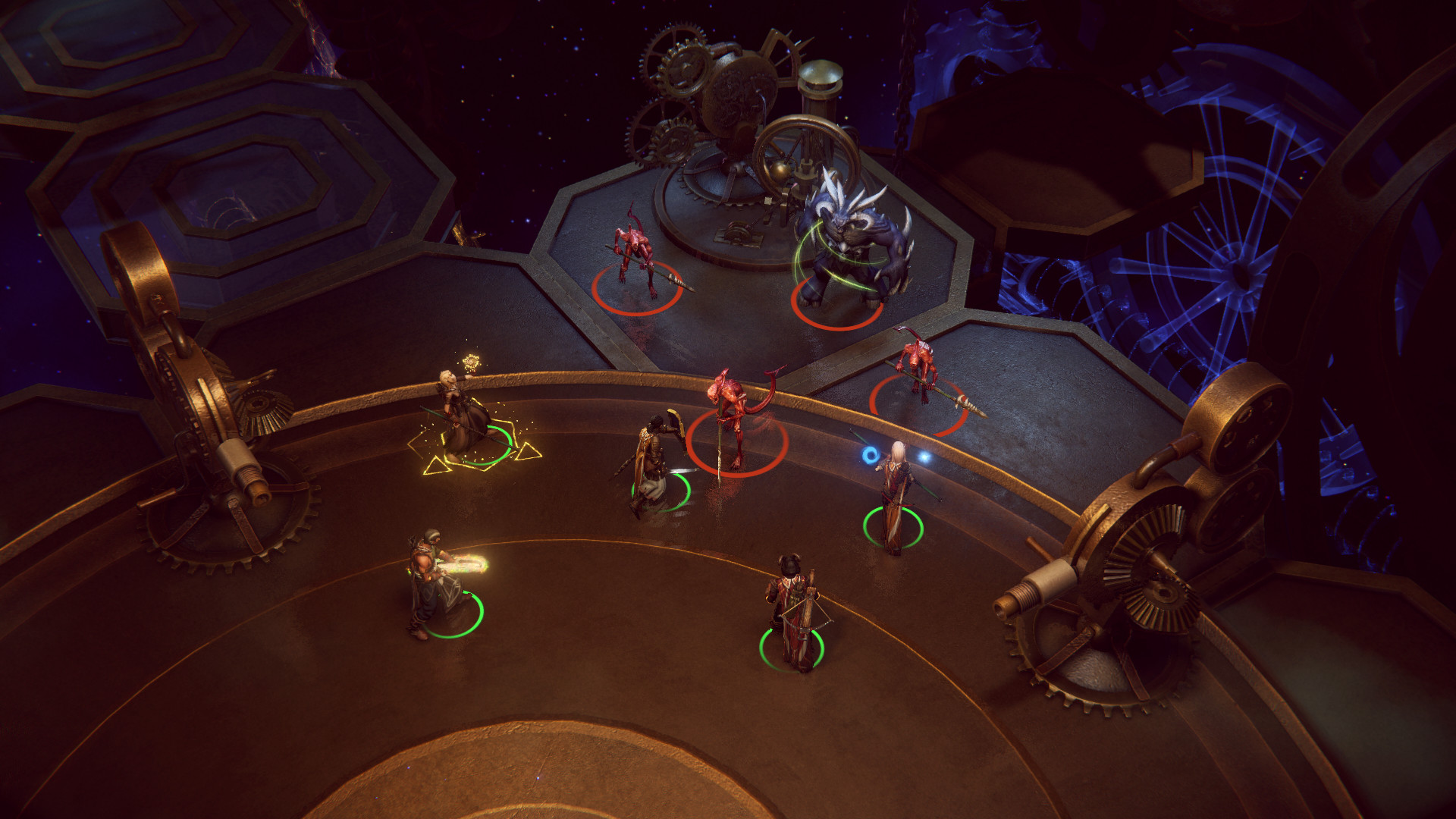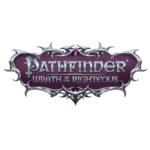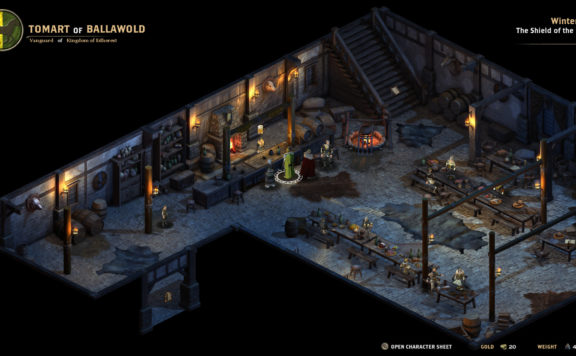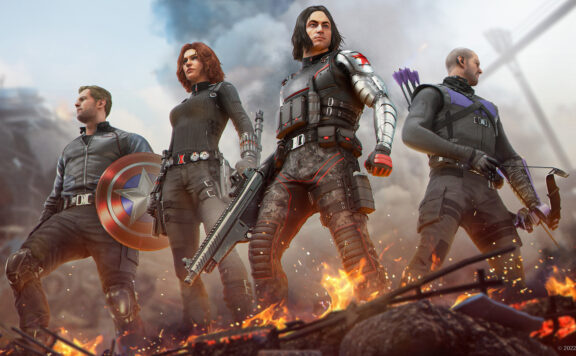Inevitable Excess is the first major story-driven DLC released for Owlcat Games’ cRPG Pathfinder: Wrath of the Righteous. You can purchase the expansion separately or acquire it as a part of the game’s Season Pass which will also grant you access to the two more planned DLCs when they are out.
With the Heaven and Abyss already locked into the conflict on Golarion, it is time for the Commander of the Fifth Crusade to set their eyes and Mythic Powers on Axis, the plane of law and order, and Maelstrom, the plane of chaos and change, and do some good ol’ crusading.
But is it really that simple? Clutch Nenio closer for her absolutely unbiased commentary and read on to find out!
Note: this review contains heavy spoilers for the endgame of the base game and the overall content of the DLC.
Before we proceed, first let’s talk about what is and what is NOT in this DLC. If you expect something akin to Dragon Age: Inquisition – Trespasser or Divinity 2: Flames of Vengeance, a new story set after the events of the main campaign that shows you some of the consequences of your decisions and how they shaped the world, you will not find it here. The DLC is more of a step sideways from the main story.
The events of Inevitable Excess take place right before the Commander’s final confrontation with Areelu Vorlesh in the fallen Threshold fortress. Thanks to some wibbly wobbly timey wimey magic, you find yourself summoned by the primordial inevitable Valmallos. The big guy is a mechanical aeon and a guardian of magic created to act when there is a magical threat against the world order.
Surprise, between the Commander’s Mythic power and nascent semi-divine abilities, the phenomenon that is the Worldwould and its Architect, the involvement of the Demon Lords and Gods and their followers, that moment has arrived a few times over. Now it is up to the Commander (but not really) and the companions (but not really) to follow the call of Valmallos, defeat the occurring anomalies and save Golarion (but not really) from the impending catastrophe striking at time-space continuum.
To experience the content of the DLC, you can either import your character from the main game or create a high-level hero from scratch to take on the new challenges. Until the arrival of the endless dungeon DLC akin to the Beneath the Stolen Lands, it might be the best possible way to test out various builds and Mythic Paths in their prime.
Once the DLC is over, it goes to The End black screen and does not pick up where it so rudely interrupted the Commander – however, you get a nice buff for all your characters, including the future ones. Below you can find the screenshot of the new shiny ability granted to my Angel Commander after beating the DLC.
Why does it do that? Because, from the point of view of the Commander of the Fifth Crusade, Mythic companions or denizens of Golarion, as in the people who actually matter, the events of Inevitable Excess never happened. More on that below.
Inevitable Escape
Valmallos’ explanation has some very glaring holes and soon you will uncover the truth – the protagonist of the DLC is not the Commander per se but rather the Excess of the Mythic Power given form, memories and abilities of the leader of the Fifth Crusade. Your companions are essentially an extension of that power as well.
The familiar locations that you are traversing – Iz, Threshold, Artisan’s Tower, etc. – are not the Golarion you’ve come to know. Rather it is an atemporal repository created on Axis, made in the image of Golarion, and meant to contain you, forever stuck in a stasis. However, the Excess is not the only captive of the Axiomites and the Inevitables. The other prisoners are using this newly presented opportunity to their advantage, looking for a way out of Axis and their eternal detainment.
Among them are the Proteans, the embodiments of primordial chaos of Maelstrom and old enemies of Axiomites, and Ssila’meshnik – a Protean Lord locked away for their chaotic ways. The Colorless Lord’s plan involves destabilizing the Excess’ prison with anomalies and using the ensuing chaos to escape Axis. Some of the anomalies appear as familiar characters acting in strange ways. Players will be able to run into the Storyteller, Irabeth & Anevia, Hilor, and others and experience their stories from a slightly different angle.
Additionally, the DLC introduces a bit of the multiverse madness by allowing you to interact with Mythic Path-specific NPCs that believe you to belong to the aligned Path: Lariel and Targona (Angel), Aranka (Azata), Yozz (Demon), Mephistopheles (Devil), Zacharius & Co (Lich), Thaberdine (Trickster). Poor confused Mephistopheles believes you are simultaneously a fallen Azata and a renegade Aeon. Swarm-That-Walks, as per the course, gets to eat everybody. Aeon, Trickster and – after the recent patch – Demon, Azata and Lich have some interesting interactions. The Legend and Gold Dragon Mythics lack in content compared to the rest.
The idea of the Commander’s – or, in this case, the Excess’ – powers causing a split in reality is a fun one, and something I’d have loved to explore more beyond the scope of a dozen of errands. Imagine the madness that could be wrought by the Commander who is narratively if not mechanically a bit of every Mythic Path at once as reality is struggling at the seams.
Ultimately, the errands are a small nod to the base game’s variety that really go nowhere in terms of the overall story of the DLC.
 As you tackle the side-quests, there is a thin thread of plot connecting many of the events and dialogues together: is an anomaly – or in your case an Excess – a person or simply embodied power? If so, are they equal to their original? Are their feelings artificial, implanted into them alongside memory, or real? Does it even matter?
As you tackle the side-quests, there is a thin thread of plot connecting many of the events and dialogues together: is an anomaly – or in your case an Excess – a person or simply embodied power? If so, are they equal to their original? Are their feelings artificial, implanted into them alongside memory, or real? Does it even matter?
Anomaly-Irabeth confesses to still loving Anevia, even if she is aware she is not “the original”. Arueshalae, a companion created from your Mythic power, wonders if she should feel the crushing guilt of the past in the Abyss if she isn’t technically the one who lived it. Areelu’s Excess vehemently claims to be a different person from the Architect of the Worldwound but cannot help but feel certain fondness for the Commander’s Excess.
However, those little clusters of character development and plot are smeared in a very thin layer across hours of dungeon crawling, doing puzzles and side-quests and fighting against waves of mobs. And so, when the conclusion comes, it is too little, too late.
Players are able to choose between four primary endings depending on which side you decide to join or fight against – Order, Chaos, Paradox and Nothing. The latest patch also added Demon and Azata-specific choices to the final conversation.
The companions get some interactions and rest banters, with the most chatty ones seemingly being Regill, Daeran and Nenio, with Arueshalae following up closely. Less popular choices like Sosiel, Trever or Galfrey are almost completely non-existent.
Overall, the story of the DLC is a bit of superficial fun with the alternative universe elements, especially for those familiar with multiple Mythic Paths. The execution of the idea leaves much to be desired, however, especially when it swaps from quirky errands to melancholic main story all of the sudden. The expansion doesn’t explore the story deep enough to receive the emotional response it tries to provoke.

Inevitable Defeat
Having spoken (entirely too much) about the story of the expansion, let’s take a look at the gameplay it offers – although there is nothing fundamentally new or different from the base game.
When I read the description of the Inevitable Excess, I expected a fewer number of battles against the “nigh-invincible enemies”, immediately thinking back to facing Darrazand, Playful Darkness, Xanthir, Melazmera, even Vavakia Vanguard, all juiced up to account for the party’s increased strength.
That is very much not the case.
Players will be facing off against two new types of enemies – the Axiomites and the Proteans. But the bulk of the enemies will be represented by the anomalous versions of the previously encountered demons and undead – Babau, Succubus, Vavakia, Zombie Lord, etc. In order to keep the Mythic Excess party from simply rolling over the waves of enemies, they have been given high AC, immunities/resistances as well as ways to reduce their chances of being hit: Blur, Replacement, Mirror Image, etc. Hopefully you brought True Seeing and Echolocation along!
At no point during the DLC have I actually felt that my party was in any danger of an inglorious wipe. The enemies’ defeat was inevitable, it simply took time, sometimes entirely too much of it. Of course, if you are playing on a higher level of difficulty, your experience might be different.
The other side of gameplay includes puzzles. I have to admit to being somewhat geographically-challenged and, having received a special ability that amounted to endless uses of Dimension Door: Mass, letting out a loud groan. Spatial puzzles. My nemesis in the digital form.
A lot of your time will be spent running and teleporting between floating and shifting platforms to tug at cogwheels and levers and hoping it would actually achieve something.
Admittedly, looking back after having finished the DLC, the puzzles weren’t that bad. But the lack of guidance on what you are required to achieve and how to go about it made the Other Side of Threshold a grueling experience of swinging the camera around, trying to find what I have missed and where I haven’t yet been. You might want to look up a guide to save yourself the trouble.
Summary
While playing through the DLC, I couldn’t shake off the feeling of déjà vu – not from the story or gameplay themselves, but rather from the confused emotions they evoked in me, eerily similar to my playthrough of Seeker, Slayer, Survivor DLC for Pillars of Eternity 2: Deadfire. Both Obsidian and Owlcats seemingly ignored the stronger parts of their respective games to pursue something else.
It felt like the team created two lists of the game’s features. The first contained the elements universally beloved by the fans: the story, companions, Mythic Path interactions, high reactivity, etc. And the second was filled with the things that could use some help: unobvious puzzles, drawn-out combat, lack of consequence, shallow endings… And then erred in which list to use to build the backbone of the DLC content, leaving Inevitable Excess unsure of what story it wants to tell and which features it should prioritize.
Overall, Inevitable Excess is a small addition to Pathfinder: Wrath of the Righteous that doesn’t quite measure up to the base game. I’d tentatively recommend it to players looking for more Pathfinder content as long as they know what they are getting into and don’t mind getting lost in the Other Side of Threshold.
Now for something highly subjective that had no effect on the overall score in the end:
For me personally the biggest drawback of the DLC is its missed potential when it comes to more character screen-time. The two upcoming DLCs will feature a separate cast of playable characters like in Varnhold’s Lot and an endless dungeon that is not known for wealth of story and character depth, respectively.
That means that, unless the developers expand the content of Chapters 5 & 6 in the Enhanced Edition or release a surprise DLC akin to ME3’s Citadel, Inevitable Excess was the last chance for some extra endgame content featuring the characters I’ve grown to love over my ridiculously long stay in PF: WotR.
And, with everything said and done, it ended up not even really being them.









